CHP 5 human development
1/78
There's no tags or description
Looks like no tags are added yet.
Name | Mastery | Learn | Test | Matching | Spaced |
|---|
No study sessions yet.
79 Terms
is a developmental checklist reason enough to warrant OT services?
NO always perform your own assessments
prenatal period
conception to birth; gestational period
SENSORIMOTOR:
all neonatal reflexes are present at 29wks gestation (not fully developed)
innate tactile, prop, and vestibular rxn
response to tactile as early as 5.5 wks
response to sound at 24wks
early infancy
birth to 3 mos
SENSORIMOTOR:
tactile, prop, and vestibular begin to integrate and refine
visual continues to develop with response to stimuli 10in from face
auditory system develops to orient to typical voices
integration of primitive oral motor reflexes for feeding
integration of motor skills for head righting and turning head
changes in sensory input may overstimulate
middle infancy
4-6 mos
general SENSORIMOTOR:
tactile and prop continue to refine = incr awareness and interest in world
vestibular, prop, and visual integrate for postural control and facilitating stable visual field
visual and tactile system become integrated for reaching and primitive grasp
play at midline
movement patterns progress from reflective to voluntary and goal directed
late infancy
7-9 mos
general SENSORIMOTOR:
vestibular, visual and somatosensory responses incr in quality = more mobile and coordinated movements
tactile and prop become more refined allowing development of FM skills and motor planning
transitional infancy
10-12 mos
general SENSORIMOTOR:
tactile and prop improve = development of midline skills and crossing midline
auditory, tactile, and prop heightened for development of sound and communication
tactile, prop, gustatory, and olfactory integrated for self-feed
infancy
earliest period of post-natal life
birth through 1 year
divided into 4 periods
early infancy
middle
late
transitional
emerging toddler
13-24 mos
general SENSORIMOTOR
tactile becomes more precise for localization and discrimination
balance and dynamic posture control stronger
further integration for complex motor planning > incr self-concept
symbolic gesturing and vocalization > ideation and ability to conceptualize
toddler
2-3 years
general SENSORIMOTOR:
vestibular, prop, and visual further develop and refine for improved balance and postural control
tactile discrimination and localization skills > improved FM
motor planning and praxis ideation = incr planned actions and play
preschool/early childhood
3-5 years
general SENSORIMOTOR:
PLAY based improvements
child challenges and develops sensorimotor competencies for roughhouse play, playground ax, games, sports, dancing, arts, and school tasks
social development and self esteem
refinement of sensory systems for independence in mobility and improved FM skills
rooting reflex
stimulus, response, fxn sig, onset age, integration age
stimulus: stroke corner of mouth, upper lip, and lower lip
response: movement of tongue, mouth, and head during stimulus
fxn sig: helps body locate feeding source
onset age: 28 wks gestation
integration: 3 mos
suck-swallow reflex
stimulus: place index finger inside mouth with head in midline
response: strong, rhythmical sucking
fxn sig: facilitates nutritive sucking for ingestion of liquid
onset age: 28 wks gestation
integration: 2-5 mos
traction reflex
stimulus: grasp infant forearms and pull-to-sit
response: complete flexion of UE
fxn sig: promote momentary grasp to enabled child to hold onto mother when being pulled
onset age: 28 wks gestation
integration: 2-5 mos
moro reflex
stimulus: rapidly drop infants head backwards
response:
first phase: arm extension/abduction, hand opening
second phase: arm flexion and adduction
fxn sig: protective response to stress; helps develop extensor tone during period when flexor tone is dominant
onset age: 28 wk gestation
integration: 4-6 mos
plantar grasp reflex
stimulus: apply pressure with thumb on infant ball of foot
response: toe flexion
fxn sig: incr input to sole of foot; integration associated with readiness for indp gait
onset age: 28 wks gestation
integration: 9 mos
galant reflex
stimulus: hold infant in prone suspension, gently scratch or tap alongside spine with finger from shoulder to butt
response: lateral trunk flexion and wrinkling of skin on stimulated side
fxn sig: enhances trunk stabilization by facilitating lateral trunk movement
onset age: 32 wk gestation
integration: 2mos
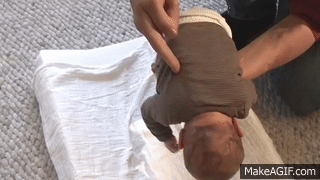
Asymmetric tonic neck reflex (ATNR)
stimulus: fully rotate infants head and hold for 5s
response: extension of extremities on face side, flexion of extremities on skull side
fxn sig: promotes visual attention to UE; decr incidence of rolling
onset age: 37 wks gestation
integration: 4-6 mos

palmar grasp reflex
stimulus: place finger in infants palm
response: finger flexion; reflexive grasp
fxn sig:
incr palmar tactile input
prepares muscles for voluntary grasp
onset age: 37 wks gestation
integration: 4-6mos
tonic labyrinthine (supine) reflex
stimulus: place infant in supine
response: increased extensor tone
fxn sig:
facilitates full body extensor tone
allows posture to adapt to that of head
onset age: 37 wks gestation
integration: 6ms
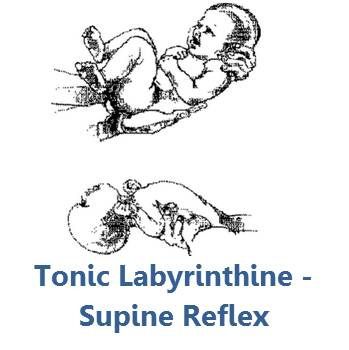
tonic labyrinthine (prone) reflex
stimulus: place infant in prone
response: increased flexor tone
fxn sig:
facilitates full body flexor tone
allows posture to adapt to head
onset age: 37 wks gestation
integration: 6mos
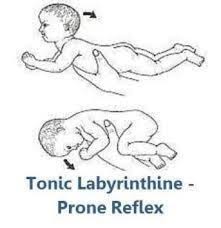
landau reflex
stimulus: hold infant in horizontal prone suspension
response: complete extension of head, trunk, and extremities
fxn sig:
regulates tone
promotes prone extension to manage flexor tone
onset age: 3-4 mos
integration: 12-24 mos
real EX: lifting baby in air over head to play and they have extremities ext

symmetric tonic neck reflex (STNR)
stimulus: place infant in crawling position and extend the head
response: flexion of hips and knees
fxn sig:
facilitates quadruped position in preparation for crawling
breaks up total-body extension
onset age: 4-6mos
integration: 8-12mos
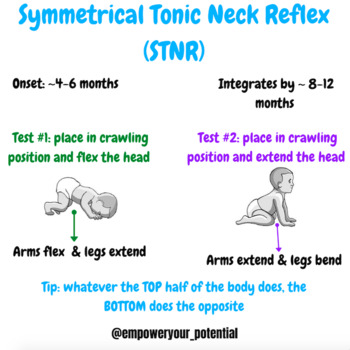
neck righting on body (NOB)
stimulus: place infant in supine and fully turn head to one side
response: log rolling of entire body to maintain alignment with head
fxn sig:
facilitates rolling
maintains body orientation in response to cervical position changes
onset age: 4-6mos
integration: 5yrs

body righting on body (BOB)
stimulus: place infant in supine, flex one hip and knee toward the chest and hold briefly
response: segmental rolling of upper trunk to maintain alignment
fxn sig:
promotes trunk and spinal rotation to facilitate sitting and quadruped positions
onset age: 4-6mos
integration: 5yrs
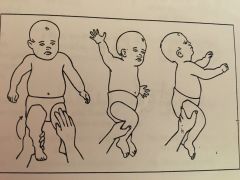
reflexes that persist throughout life
3 main
labyrinthine/optical righting
protective extension:
downward parachute (protective extension downward)
forward parachute (protective extension forward)
sideward parachute (protective extension sideward)
backward parachute (protective extension backward)
tilting:
prone, supine, sitting, quadruped, standing
labyrinthine/optical (head) righting
stimulus: hold infant suspended vertically and tilt slowly (45deg) to side forward or backward
response: upright positioning of head
fxn sig:
basis for head management and postural stability
orients head in space vertically
onset age: birth-2mos
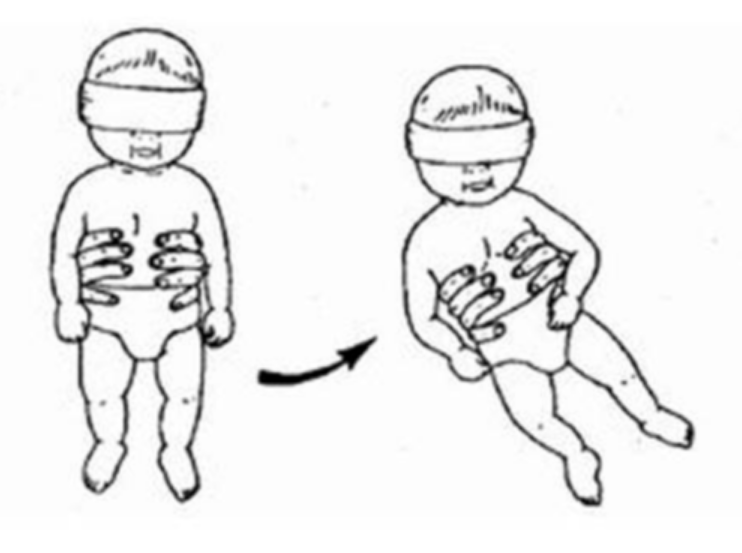
downward parachute (protective extension down)
stimulus: rapidly lower infant toward supporting surface while suspended vertically
response: ext of LE
fxn sig:
prepares LE for surface contact
breaks fall
onset age: 4mos
forward parachute (prot. ext)
stimulus: suddenly tip infant forward toward supporting surface while vertically suspended
response: sudden ext of UE, hand opening, and neck ext
fxn sig:
place UE in anticipation of surface to break fall
supports prop sitting
onset age: 6-9ms
sideward parachute (prot. ext.)
stimulus: quickly but firmly tip infant off balance to side while in sitting
response: arm ext and abduction to side
fxn sig:
unilateral support body for use of opposite arm
prevent fails
onset age: 7mos
backward parachute
stimulus: quickly but firmly tip infant off balance backward
response: backward arm ext or arm ext to one side spinal rotation
fxn sig: protect from backward fall
onset age: 9-10mos
tilting reflexes
what
types & onset age
stimulus: tilt baby while in appropriate position
rxn: curve spine toward raised side, abduction/extension of arms and legs
types:
prone: 5mos
supine & sitting: 7-8mos
quadruped: 9-12mos
standing: 12-21mos
purpose: adjust center of gravity and preserve balance

general principles for motor development (5)
occurs in cephalocaudal/proximal to distal direction
EX: core strength and sitting balance before standing and walking
progresses from gross to fine movement
progresses from stability to controlled mobility
occurs in spiraling manner, with periods of equilibrium and disequilibrium
sensitive periods occur when child is affected by environmental input
STABILITY: 0-4 ms
prone
supine 0-3m & 3-4m & 4-5m
sitting 0-3m
PRONE
lifts head and sustains at midline
rotates head freely when supported
bear weight on forearms & can tuck chin and gaze at hands in forearm prop
attempt to shift weight on forearms > shoulders collapse
SUPINE:
0-3ms
holds head to one side
turn head from side to side
3-4ms
hold head in midline
tuck chin and extend neck
bring legs together in midline
4-5ms
no longer has head lag when pulled to sitting
begins to play with hands in midline away from body
SITTING
0-3ms
bobs head and moves side to side > steady
right head, rounded back, hips apart & turned out
tuck chin and gaze at floor
less support, hips bent and shoulders in front of hips (bad center gravity)
STANDING
0-3ms
some weight on legs when held
3-4ms
hold head up at midline
aligns pelvis and hips; turns legs outward and apart (starfish)
STABILITY: 5-6ms
prone
supine 4-5ms & 5-6ms
sitting
standing
PRONE
bear weight and shift weight on extended arms
shift weight on forearms and reach forward
lies prone with hips and legs extended
equilibrium rxns
SUPINE:
4-5ms
no longer has head lag when pulled to sitting
begins to play with hands in midline away from body
5-6ms
lift head independently & actively kick legs
feet > mouth & hands to feet
reaches for toy uni or bilaterally
maintain thumb and finger ext with open palm (open hands)
SITTING
sits alone momentarily
incr back ext, props forward on arms, wide base with legs bent
STANDING:
incr bear weight, less support (hold by arms or hands); bounces
STABILITY: 6-8ms
prone
supine 7ms
sitting 7-8ms & 8-10ms
standing 6-9ms
PRONE
lifts chest and thighs off surface
exhibits airplane posturing in prone
pivots in prone
moves from prone to sitting
SUPINE (7ms)
equilibrium rxn
SITTING
(7-8ms)
equilibrium rxn
rotate upper body with lower stationary
protective responses to side
8-10ms
sits well w/o support; plays in sitting
legs closer together, full upright, knees straight
variety sitting positions (W and side)
sitting > prone indp
STANDING
6-9ms
pulls to stand
STABILITY: 9+ms
prone 9ms
sitting10-12ms
standing:
PRONE
begins to dislike prone
SITTING:
10-12ms
protective ext back
move in/out positions
fully developed trunk & equilibrium rxn
STANDING:
9-12ms
pull to stand with legs only
stands alone momentarily
equilibrium rxn
weight shift
rolling
3-4ms
5-6ms
6-14ms
3-4ms
accidental roll from prone
roll supine to side
3ms belly to back
5-6ms
prone > supine
supine > side w/indp movements
supine > prone w/indp movements
6mos back to belly
6-14ms
segmented rolls
crawling & creeping
7ms
crawls on belly
7-10ms
reciprocal creep
10-11ms
creeps on hands and feet
11-12ms
creeps well on variety surfaces and inclines
cruising and walking
5-6ms
high guard position (wide based gait & arms ext)
protective ext to front
8ms
cruises sideways
9-10ms
cruise around furniture with slight turn to intended direction
10-12ms
stoops and recovers
walks with mod support (hand held)
reaches for furniture out of reach when cruising; cruises in either direction no hesitation
12-15ms
walks with wide gait
15-18ms
frequent falls w/wide gait
runs stiffly with eyes on ground
climbing
15-18ms
climbs on and off surfaces
creeps up stairs
18-24ms
walks up&down stairs while holding on
creeps backwards down stairs
2-2.5yr
walks up&down w/o support w/time and no alternating of feet
2.5-3yr
walks UP stairs alternating feet
3-3.5yr
walks DOWN stairs alternating
jumping
2yr
jump down from step
3yr
jump off floor with both feet
3-4yr
gallops
4-5yr
jump over object
hops on one foot
5yr
hops straight line
5-6yr
skips alternating feet
reaching
0-2ms
visual regard & batting w/closed hands in supine
3-4ms
direct arm movement in supine
hands together at midline for bilateral reaching in supine
5ms
bilateral reaches > secures > holds object to body in supine
indirect reach in supine
weight shift in prone to reach w/closed fist (still tricky to grab)
6ms
unilateral reach incr, more open hand, more direct reach & success in supine
weight shift in prone to grab with more success
7ms
weight shift and grab while on hands and knees/ unilateral grab
9ms
reaching unilateral and bilateral all position more success
grasping a cube
0-1ms
visual attention & reflexive grasp
3ms
sustained voluntary grasp
uses ulnar side with no thumb involvement
4-5ms
primitive squeeze > ulnar palmar grasp w/fingers on top surface, object in center palm and thumb adducted
4 MONTHS Primitive Squeeze Grasp
5 MONTHS Palmar Grasp
6-7ms
6 MONTHS Radial Palmar grasp
wrist straight (7ms)
8ms
8 MONTHS radial digital grasp
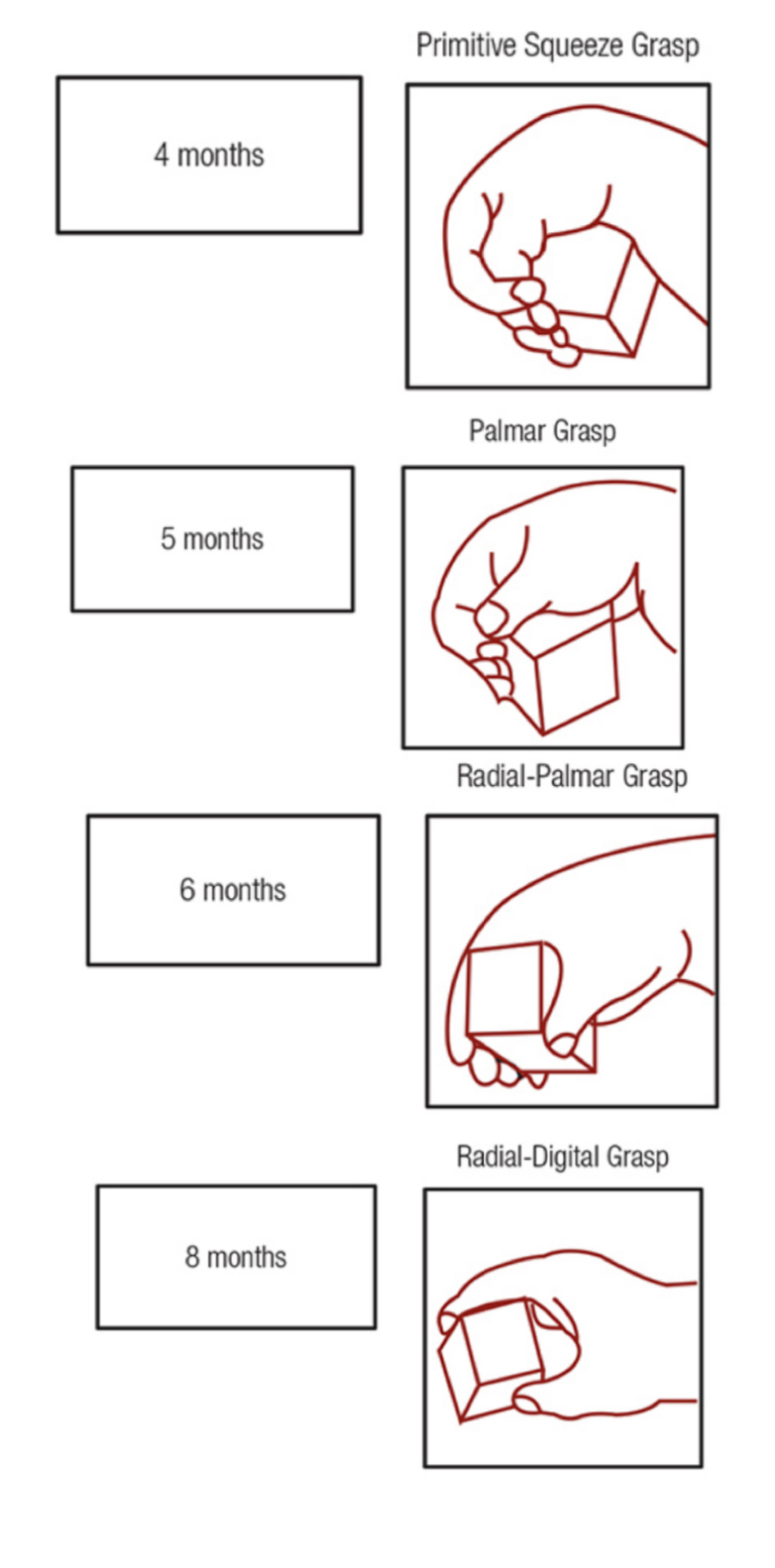
Grasping Pellet
0-3ms
NO voluntary grasp or NO visual attention to pellet sized object
3ms > visual attention w/out grasping attempts
6ms
swiping/raking
7ms
inferior-scissor grasp
raking with adducted, flexed thumb and flexed fingers
clawing with mittens
8ms
scissor grasp
thumb and side of index finger
9ms
inferior pincer grasp
10ms
pincer grasp
btw pads of fingers
12ms
fine pincer grasp
fingertips
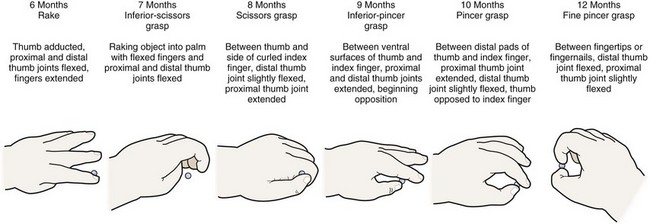
power grasp
when
how
ex
WHEN: used to control tools or other objects & when hand strength is required
hook, spherical, and cylindrical are often considered types of power grasps
HOW:
object held obliquely in hand w/ ulnar fingers flexed and radial fingers less flexed. thumb ext and add.
stabilize with ulnar and control with radial
EX: using a hammer
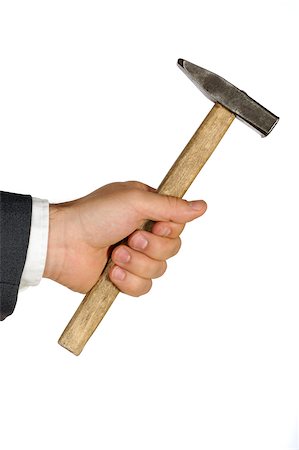
hook grasp
when
how
EX
WHEN: to carry objects such as purse or briefcase
HOW:
transverse metacarpals arch is flat, fingers adduct w/flex at IP; MCP flexed or ext
EX: holding a purse or briefcase

spherical grasp
when
how
WHEN: to hold small ball
HOW:
wrist ext, fingers abduct w/flex at MCP and IPs; hypothenar eminence assists in cupping and control of objects

cylindrical grasp
when
how
WHEN: hold glass, cup, or can with hand around object
HOW:
transverse arch flat against object; fingers abduct; IP and MCP flex

disk grasp
WHEN: hold disk such as jar lid
HOW:
finger hold disk with ext of MCP and flex of IP; wrist flex and thumb ext with larger objects; only pads of fingers touch object

lateral pinch
when
how
WHEN: to exert power on or with small object
HOW:
index finger slightly flexed and thumb flexed and adduct'; pads of fingers on radial side of index finger near DIP
EX: holding a key

pincer grasp
WHEN: hold and handle small objects and precision tools
HOW:
thumb opposed to index finger pad and object held in finger pads; ulnar fingers flexed (pad to pad)
EX: holding a pencil, holding a coin, rolling a dough ball btw finger and thumb > using the PADS
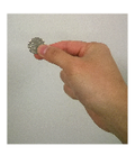
three jaw chuck (tripod) grasp
WHEN: hold and manipulate writing utensil or eating utensil
HOW:
thumb simultaneously opposed to index and middle finger pads

tip pinch
used to prehend and hold tiny objects
HOW:
thumb opposed with thumb tip meeting index tip forming circle
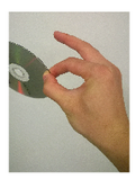
object manipulation and release skill development
0-1ms:
no release
1-4ms
involuntary release
5-6ms
two stage transfer
taking hand grasps object before releasing hand lets go
6-7ms
one stage transfer
taking hand and releasing hand perform actions simultaneously
7-9ms
voluntary release
15ms-2yrs
finger-palm translation
2-2.5yr
palm-finger translation
simple rotation
unscrewing bottle cap (90deg or less)
3-6yrs
object shift
separating paper, turning page, shifting pencil or marker
6-7yrs
complex rotation
turning pencil over to eraser
bilateral hand use
asymmetric movements until 3ms > symmetric movements until 10ms
by 12-18ms infant uses both hands for different functions
18-24ms manipulation skills
2.5yrs uses two different hands for different functions
development of prewriting and writing skills
8-12ms
mouths writing utensil & crinkles paper
12-18ms
scribbles; arm moves are unit
12-16 MONTHS cylindrical grasp
12-18 MONTHS palmar supinate grasp
2-3yrs
digital pronate grasp
3.5-4yrs
statis tripod
hand moves as unit
4.5-6yrs
dynamic tripod
4-5yr: copies letters and numbers
5-6yr: write name with upper and lowercase
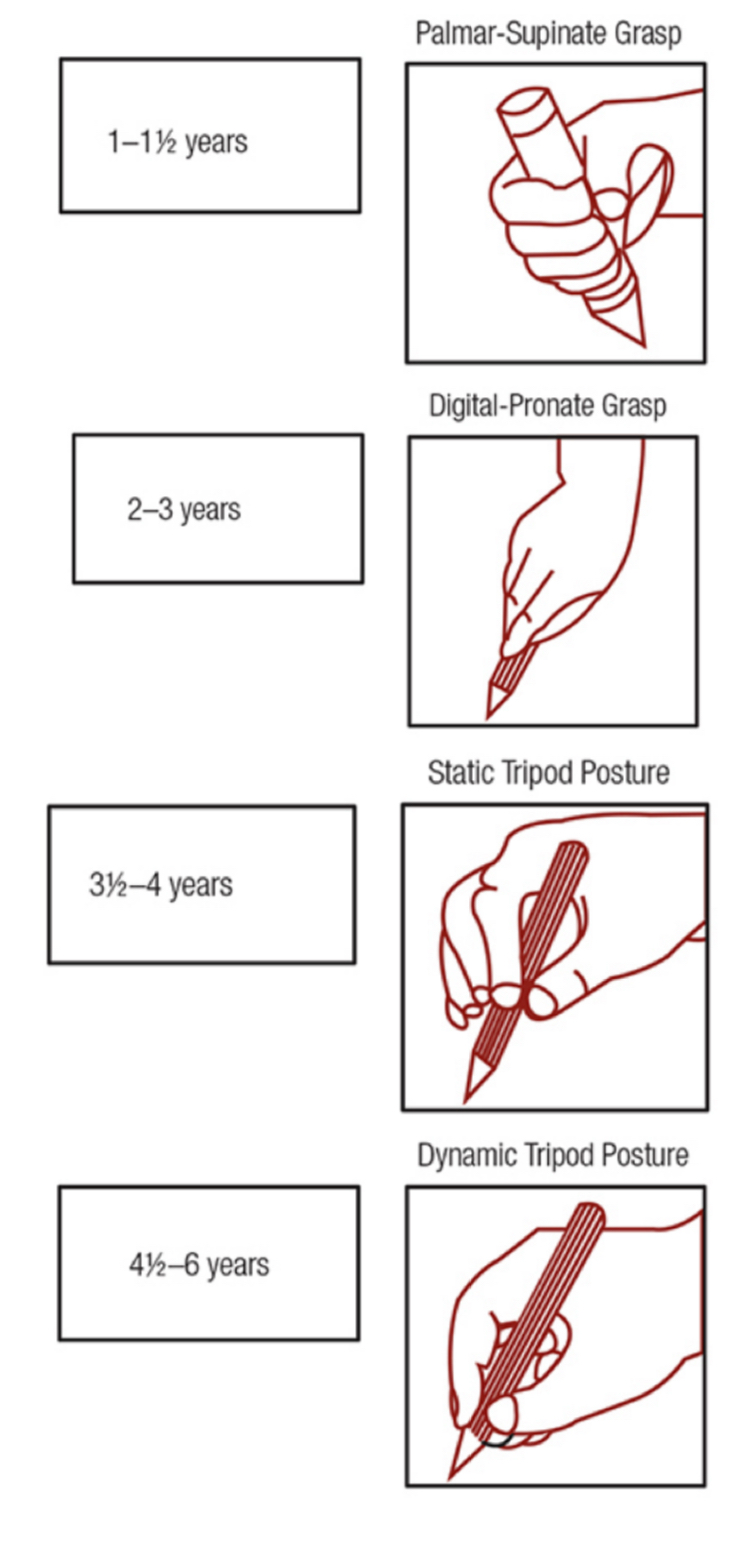
scissor skills development
1-2yr
none
2-3yr
holds and snips; opens/closes in controlled fashion
3-4yr
cut with jagged snips
cut straight and curved lint with guide
cut simple circle using helper hand
4.5-5yr
cut simple shapes
5.5-7yr
cut complex shapes
development of drawing skills
1-2yrs
scribbles w/out intent
2-3yrs:
scribbles with intent
imitates vertical and horizontal lines and circles
3-4yrs
scribbles and draws more recognizable simple shapes
human figure with 1-3 features
4.5-5yr
intentional drawings
recognizable but maybe unrealistic features
5.5-7yr
detailed and thoughtful drawings
Piaget
4 stages
sensorimotor
birth to 2yrs
child uses sensorimotor skills to develop understanding of world and progress from reflexive activity to cognitive function
preoperational
2-7yrs
progresses from dependence on perception and egocentric thoughts to logical and problem solving; engage in symbolic and verbal play
concrete operations:
7-11yrs
use logical thinking on observed or mentally represented objects; enjoy games with rules
formal operations
11-teens
logic to hypothesize problem solving and can draw from past and present experiences
early object use milestones
3-6 mos
banging and shaking
6-9mos
explores objects; pulling turning poking tearing
8-9mos
relational play; placing objects in containers
9-12mos
complex actions; opening doors, placing lids, pushing train, rolling ball
12-15mos
placing baby in carriage and pushing (simple schema combos)
24-36mos
multischema combo; put food in bowl, scoop food with spoon, and feed doll
36-42mos
complex scripts
exploratory play
0-2yrs
child engages in play experiences to develop body schema
sensory integrative and motor skills develop
mostly with parent or caregiver
symbolic play development
12-18ms
basic make believe play, primarily involving self (sleeping, eating,)
imitates familiar activities
18-24mos
increases non-realistic objects in pretending (block for train)
inanimate objects perform familiar activities (doll washes herself)
2-4yrs
play experiences with refined ideas, emotions, and actions
creative play
4-7yrs
sensory, motor, cognitive, and social play to refine skills
explores combo of actions
cooperative peer groups
game play
7-12yrs
rules, competition, social interaction, and skill development
cooperative peer groups
oral motor development
4-5mos
strong sucking, good lip closure, tongue moves up and down, munching
7-8mos
mastication of soft and mashed foods with diagonal jaw movements
9mos
lateral tongue mvt for effective mastication of mashed and soft foods; drink from cup but jaw not firm
12mos
jaw is firm, rotary chewing for good bite on hard cookie
24mos
able chew most foods, well-graded sustained bite, drink from cup with firm jaw
development of self-feeding
5-7mos
take cereal or poured baby food from spoon
6-8mos
attempts to hold bottle; needs to be monitored for safety
6-9mos
hold and tries to eat cracker but sucks more than bites
consumes soft foods that dissolve in mouth
grabs spoon but bangs or sucks on either end
9-13mos
finger-feeds self portion of soft table foods
12-14mos
dips spoon in food, brings spoonful to mouth but spills by inverting spoon
15-18mos
scoops with spoon and brings to mouth
24-30mos
interest in fork; stab at food; proficient in spoon
development of toileting skills
1-2yrs
knows & is distressed when wet, cooperates with changings, regular bowel movements
2-2.5yr:
POTTY TRAINING
regular urination, bowel accidents rare, interest in toileting, knows when they need to go, cooperates for limited time when placed on potty; may need help with clothing managment
3-4yrs
toilet on own, may need help with hygiene or clothes management (fasteners)
4-5yrs
daytime & nighttime control
indep on toilet but may need help for difficult clothes
5-6yrs
completely indp
development of self-dressing
1yr
cooperates with dressing, puts arms up for don/doff, extends legs, removes socks
1.5-2yr
DOFF > unfastened clothes & shoes, mittens
helps pull pants down, pushes arms through holes when shirt placed on head
2.5-3yr
assist & attempts to DON » easy shoes, socks
DONS pullover shirt, open front jacket
unbuttons, unsnaps, unzips (&zips when on track) easy fasteners
3.5-4yr
DON > easy shoes, elastic pants, pullover shirt, mittens
recognizes correct clothing orientation
buttons, zips, snaps, fastens, and unbuckles easy fasteners
large buttons, 3-4 button series
4.5-5yr
indp don/doff body clothes
indp with buckles
minimal assist for difficult fasteners & tying laces
5-6yrs
INDP > difficult fasteners & tying shoes
development of IADLs
2-3yrs
imitate chores, follow easy cleanup directions, wipes up spills, fills pet food dish
4-5yrs
prepare simple snacks, set table, empty dishwasher, sort laundry, make bed, water, feed pets, sort trash, etc.
6-7yrs
make & pack lunch, help meal prep, wash & dry unbreakable dishes, tidy up
8-9yrs
prepare hot meal, load dishwasher, wash/dry breakable dishes, walk pets, mop, fold & put away laundry
10-11yr
clean kitchen/bathroom, help with shopping, change bed
12+
meal prep, laundry & ironing, grocery shop, wash car, simple home repair, manage house machines (washer/dryer)
neonatal assessments (2)
Assessment of Preterm Infants Behavior (APIB)
Neurological Assessment of Preterm and FullTerm Newborn Infant (NAPFI)
Comprehensive developmental assessments (7)
Bayley Scale of Infant Development 3 (BSID-III)
Developmental Assessment of Young Children (DAY-C)
Denver Developmental Screening Test II
First STEP Screening Test for Evaluating Preschoolers
Goal-Oriented Assessment of Lifeskills (GOAL)
Hawaii Early Learning Profile (HELP)
PEDI
Motor development assessments
BOT 2
EDPA
M-FUN
PDMS-2
TIME
issues important for aging
as you age, your body weakens and changes in every aspect; aging is complex and practice should consider an integration of theories
biological theory: focuses on cellular, molecular, and biological aspect of aging
psychological theories: address changes in cognitive, personality, and social development
sociological theories: considers context of aging
older adults are likely to have less education, altered support systems (widowed, etc.), insecure income, and possess a disability
heart disease is leading cause of death
account for a lot of healthcare costs
age-related changes to body
muscular system
muscle loss, endurance loss, balance loss > falls, sprains, tears
skeletal system
degenerative joints, stiffer, loss bone mass & density, spinal weakness, posture changes > kyphosis, falls, fractures
neurological system
atrophy nerves in brain, decr blood flow to brain, altered synaptic transmission, whole body nerve changes, tremors > decr speed, coordination, FM skills, cognition, homeostatic regulation
sensory system
loss of fxn
vision loss!!!, hearing loss, tactile loss, vestibular loss
ALL can lead to deprivation, isolation, confusion, senility, depression, decr social, decr QoL
cognitive system
Decr communication, memory, processing speed, perceptual skills
cardiopulmonary!!!
inactivity, degen of heart muscle, decr blood flow, conduction changes, changes in blood vessels incr BP, decr resp capacity, unproductive resp > reduced exercise capacity, orthostatic HTN, fatigue, decr ejection, hypoxia, no cough, aspiration
important to assess prior to exercise
integumentary (skin)
decr skin composition, decr sebaceous ax, brittle nails, loss protective barrier > skin tears & injury, dehydration, diminished touch and temperature sense
strategies to slow or reverse age-related muscular changes
improve health
increase physical activity
strength training
flexibility and ROM interventions
strategies for age-related skeletal system changes
postural exercises
weight-bearing
nutritional, hormonal, and medical therapy
strategies for age-related neurological changes
address medical problems (cerebral blood flow)
improve health, nutrition, and smoking cessation
incr physical activity
motor learning and control strategies
incr time for rxn, limited complex sequences, allow incr cautionary behaviors, promote familiarity
adapt to new body
strategies for age-related vision loss
max visual fxn (envir. mod)
allow extra time for discrimination
incr lighting, reduce glare
large print, high contrast
magnify
eye path for diplopia
safety education
signs & sx of elder abuse
physical abuse
sexual
emotional
financial
physical abuse
individual reports abuse
bruises, black eyes, lacerations, fractures and dislocations
rope marks, restraint signs
broken eyeglasses, hearing aids
under or overdosing drugs
sudden change in behavior, caregiver refuses to leave them alone with visitor
sexual abuse
individual reports
bruises around private areas
unexplained STI or genital bleeding
torn, stained, or bloody underwear
emotional abuse
individual reports
emotionally upset, agitated, withdrawn, nonresponsive
unusual behavior (sucking, chewing, biting, rocking)
financial or exploitation
sudden change in banking or account
inclusion of additional names on bank cards
unauthorized withdraw of money
abrupt changes in will or other documents
unpaid pills or substandard care despite funds